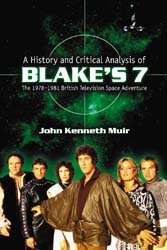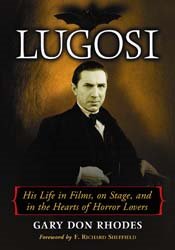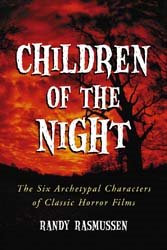Every month, I check in with McFarland to see what new film and TV titles this great publisher has on tap, and this month is a doozy. There's a lot to choose from here (including a soft-back re-release of my Blake's 7 book...). Also, I have to say that Eric Greene's book on Planet of the Apes is one of the finest scholarly film books I've ever read. It's amazing, so check it out below. I own the hard cover from years back, and it's a prized possession.
 Literature into Film-
Literature into Film- For most people, film adaptation of literature can be summed up in one sentence: “The movie wasn’t as good as the book.” This volume undertakes to show the reader that not only is this evaluation not always true but sometimes it is intrinsically unfair. Movies based on literary works, while often billed as adaptations, are more correctly termed translations. A director and his actors translate the story from the written page into a visual presentation. Depending on the form of the original text and the chosen method of translation, certain inherent difficulties and pitfalls are associated with this change of medium. So often our reception of a book-based movie has more to do with our expectations and reading of the literature than with the job that the movie production did or did not do. Avoiding these biases and fairly evaluating any particular literary-based film takes an awareness of certain factors.Written with a formalistic rather than historical approach, this work presents a comprehensive guide to literature-based films, establishing a contextual and theoretical basis to help the reader understand the relationships between such movies and the original texts as well as the reader’s own individual responses to these productions. To this end, it focuses on recognizing and appreciating the inherent difficulties encountered when basing a film on a literary work, be it a novel, novella, play or short story. Individual chapters deal with the specific issues and difficulties raised by each of these genres, providing an overview backed up by case studies of specific film translations. Films and literary works receiving this treatment include The Unbearable Lightness of Being, The Manchurian Candidate (1962), Lady Windemere’s Fan by Oscar Wilde and Shakespeare’s Henry V. Interspersed throughout the text are suggestions for activities the film student or buff can use to enhance his or her appreciation and understanding of the films. This volume also discusses the attributes of effective film translation, considers the rights and responsibilities—if any—owed to the parent text and explores the theoretical aspects of critical analysis, written or verbal, of such works. Appendices provide an aesthetic rubric; a sample decoupage and storyboard; and a list of Shakespeare’s plays translated to film. A glossary aids in understanding film and literary terms. Photographs and an index are also included.
 Mr. Sorkin Goes to Washington-
Mr. Sorkin Goes to Washington- Before the unprecedented televised presidential debates of 1960, most Americans were able to relate to their leaders in little more than an historical context. In the era of televised elections, however, the media have allowed Americans to witness the paternal, moral and intellectual qualities of their president up close. Television has been so critical to this process of political socialization that, for many Americans, the televised image of the president is the president.As the acclaimed television drama The West Wing demonstrates, fictional representations of the presidency can also be significant civic forces. This book examines how film and television drama contribute to shaping the presidency and the way most Americans understand it, and particularly the processes of political education. The text discusses The West Wing’s didactic potential, its representation of White House politics, and its depiction of race and gender, with commentary on how fictional representations of the presidency become important elements of American political consciousness.
 The Art of Laurel and Hardy-
The Art of Laurel and Hardy-From the early days of film came Laurel and Hardy, a comedy team that created slapstick hilarity from life’s simplest situations. Some seventy years after their heyday, Arthur Stanley Jefferson and Oliver Norvell “Babe” Hardy are still remembered for the comic chaos they created in film shorts. They gave us something to laugh at by reminding us of our own foibles, in a way that was genuine and unpretentious. The lanky Stan Laurel (1890–1965) and portly Ollie Hardy (1892–1957) had but one objective: to create as many laughs as would fit in one short film. And that, they did.The book begins by exploring their comedy in the early days of film. A chapter is dedicated to each of “the boys”—Laurel from Ulverston, England, and Hardy from the state of Georgia—as a person and performer. Further chapters explore the slapstick and gags of Laurel and Hardy and how the pair survived the transition to sound that left behind many actors of the day. It was only when they began to work for large studios, churning out cookie-cutter scripts, that their art began to lose its way. The book takes the reader through the ups and downs of their careers and to a final comeback. A filmography lists works from 1917 to 1951 with information on availability.
British filmmaker Peter Greenaway says life offers only two subjects: “One is sex and the other is death.” Greenaway uses both and romanticizes neither; indeed, his goal is the antithesis of the sanitary and sentimental portrayal of humanity. Although his films have met with outrage from some viewers, cult audiences praise them for insightful messages: that people are detached from violence because they fail to see others’ bodies as identical to their own; that predatory capitalism has caused humans to lose sight of our shared physicality and mortality; and that taboos are simply a system allowing people to exercise power over others.This book examines nine of Greenaway’s feature films, dedicating a chapter to each: The Draughtsman’s Contract; A Zed and Two Noughts; The Belly of an Architect; Drowning by Numbers; The Cook, the Thief, His Wife and Her Lover; Prospero’s Books; The Baby of Mâcon; The Pillow Book; and 8 ½ Women. The author examines the characters and plot, studies the structure and elements of the story, explores Greenaway’s motives and reactions, and reveals audience reactions, including comments from viewers. A filmography lists films written and directed by Peter Greenaway from 1962 to 2004.
 Planet of the Apes as American Myth-
Planet of the Apes as American Myth-Eric Greene
How do political conflicts shape popular culture? This book explores that question by analyzing how the Planet of the Apes films functioned both as entertaining adventures and as apocalyptic political commentary. Informative and thought provoking, the book demonstrates how this enormously popular series of secular myths used images of racial and ecological crisis to respond to events like the Cold War, the race riots of the 1960s, the Civil Rights movement, the Black Power movement, and the Vietnam War. The work utilizes interviews with key filmmakers and close readings of the five Apes television shows to trace the development of the series’ theme of racial conflict in the context of the shifting ideologies of race during the sixties and seventies. The book also observes that today, amid growing concerns over race relations, the resurgent popularity of Apes and Twentieth Century—Fox’s upcoming film may again make Planet of the Apes a pop culture phenomenon that asks who we are and where we are going.
 The Reel Middle Ages-
The Reel Middle Ages-Kevin J. Harty
Those tales of old—King Arthur, Robin Hood, The Crusades, Marco Polo, Joan of Arc—have been told and retold, and the tradition of their telling has been gloriously upheld by filmmaking from its very inception. From the earliest of Georges Méliès’s films in 1897, to a 1996 animated Hunchback of Notre Dame, film has offered not just fantasy but exploration of these roles so vital to the modern psyche. St. Joan has undergone the transition from peasant girl to self-assured saint, and Camelot has transcended the soundstage to evoke the Kennedys in the White House.Here is the first comprehensive survey of over 900 cinematic depictions of the European Middle Ages—date of production, country of origin, director, production company, cast, and a synopsis and commentary. A bibliography, index, and over 100 stills complete this remarkable work.
 A History and Critical Analysis of Blake’s 7, the 1978–1981 British Television Space Adventure-
A History and Critical Analysis of Blake’s 7, the 1978–1981 British Television Space Adventure-John Kenneth Muir
Blake’s 7, Terry Nation’s science fiction tale of cosmic freedom fighters, became a hit series in Great Britain when it premiered in 1978. Eight years later, the show quickly became a cult program in America. A dramatization of futuristic outlaw heroes who defend the innocent from both alien and human conquering forces, the series might better be said to be equal parts Robin Hood and The Magnificent Seven. The series defied traditional genre elements of science fiction television, and developed the concept of the continual “story arc” years before such shows as Babylon 5 and Deep Space Nine.This book provides a critical history and episode guide for Blake’s 7, including commentaries for all 52 episodes. Also included are analytical essays on the show, dealing with such topics as themes, imagery and story arc; a consideration of the series as a futuristic Robin Hood myth; cinematography and visual effects; and an overview of Blake’s 7 in books, comics and videos. A detailed appendix lists the genre conventions found in the series. The author also includes information about Blake’s 7 fan clubs and Internet sites.
The 1980s had more than its share of both emerging stars and final tributes paid to luminaries, as well as smash hits and bombs, memorable and boring performances, and new trends and tried-and-true formula offerings.The Film of the Eighties includes numerous examples of all of these. Each entry has the year of release, production company, country of origin (U.S., U.K., Australian, Canadian), leading performers and the characters they portrayed, and comprehensive credits. A brief description, review, and evaluation of the film’s cinematic values (if any) are also provided. Replacement volumes can be obtained individually under ISBN 0-7864-2738-8 (for Volume 1) and ISBN 0-7864-2739-6 (for Volume 2).
There are six of them: heroines, heroes, wise elders, mad scientists, servants and monsters. One of the most fascinating and also endearing aspects of horror films is how they use these six clearly defined character types to portray good and evil. This was particularly true of the classics of the genre, where actors often appeared in the same type of role in many different films. The development of the archetypal characters reflected the way the genre reacted to social changes of the time. As the Great Depression yielded to the uncertainty of World War II, flawed but noble mad scientists such as Henry Frankenstein gave way to Dr. Nieman (The Ghost of Frankenstein) with his dreams of revenge and world conquest. This work details the development of the six archetypes in horror films and how they were portrayed in the many classics of the 1930s and 1940s.
 Lugosi-
Lugosi-Gary Don Rhodes
Foreword by F. Richard Sheffield
He was born Béla Ferenc Dezso Blasko on October 20, 1882, in Hungary. He joined Budapest’s National Theater in 1913 and later appeared in several Hungarian films under the pseudonym Arisztid Olt. After World War I, he helped the Communist regime nationalize Hungary’s film industry, but barely escaped arrest when the government was deposed, fleeing to the United States in 1920.As he became a star in American horror films in the 1930s and 1940s, publicists and fan magazines crafted outlandish stories to create a new history for Lugosi. The cinema’s Dracula was transformed into one of Hollywood’s most mysterious actors. This exhaustive account of Lugosi’s work in film, radio, theater, vaudeville and television provides an extensive biographical look at the actor. The enormous merchandising industry built around him is also examined.
He was born Béla Ferenc Dezso Blasko on October 20, 1882, in Hungary. He joined Budapest’s National Theater in 1913 and later appeared in several Hungarian films under the pseudonym Arisztid Olt. After World War I, he helped the Communist regime nationalize Hungary’s film industry, but barely escaped arrest when the government was deposed, fleeing to the United States in 1920.As he became a star in American horror films in the 1930s and 1940s, publicists and fan magazines crafted outlandish stories to create a new history for Lugosi. The cinema’s Dracula was transformed into one of Hollywood’s most mysterious actors. This exhaustive account of Lugosi’s work in film, radio, theater, vaudeville and television provides an extensive biographical look at the actor. The enormous merchandising industry built around him is also examined.
Foreword by George E. Turner
The 1932 horror film White Zombie starring Bela Lugosi has received controversial attention from film reviewers and scholars—but it is unarguably a cult classic worthy of study. This book analyzes the film text from nearly every possible viewpoint, using both academic and popular film theories. Also supplied is an extensive intellectual history of the predecessor works to White Zombie, as well as information on the significance it carried for subsequent books and films, its theatrical release around the country, its modern cultural influence, and the attempts to restore the film to its original state. Other noteworthy features of this work include an in-depth biography of White Zombie director Victor Halperin, the first complete study of his life and career, and 244 images and photographs.
The 1932 horror film White Zombie starring Bela Lugosi has received controversial attention from film reviewers and scholars—but it is unarguably a cult classic worthy of study. This book analyzes the film text from nearly every possible viewpoint, using both academic and popular film theories. Also supplied is an extensive intellectual history of the predecessor works to White Zombie, as well as information on the significance it carried for subsequent books and films, its theatrical release around the country, its modern cultural influence, and the attempts to restore the film to its original state. Other noteworthy features of this work include an in-depth biography of White Zombie director Victor Halperin, the first complete study of his life and career, and 244 images and photographs.
Gary A. [Allen] Smith
Foreword by James Bernard
There has been a tremendous amount of renewed interest in the output of Britain’s Hammer Films. But there remain a great number of worthwhile British horror films, made at the same time by other companies, that have received little attention. The author provides a comprehensive listing of British horror films—including science fiction, fantasy, and suspense films containing horror-genre elements—that were released between 1956 and 1976, the “Golden Age” of British horror. Entries are listed alphabetically by original British title, from Vincent Price in The Abominable Dr. Phibes (1971) to Zeta One (1969). Entries also include American title, release information, a critique of the film, and the film’s video availability.The book is filled with photographs and contains interviews with four key figures: Max J. Rosenberg, cofounder of Amicus Productions, one of the period’s major studios; Louis M. Heyward, former writer, film executive and producer; Aida Young, film and television producer; and Gordon Hessler, director of such films as The Oblong Box and Murders in the Rue Morgue.
There has been a tremendous amount of renewed interest in the output of Britain’s Hammer Films. But there remain a great number of worthwhile British horror films, made at the same time by other companies, that have received little attention. The author provides a comprehensive listing of British horror films—including science fiction, fantasy, and suspense films containing horror-genre elements—that were released between 1956 and 1976, the “Golden Age” of British horror. Entries are listed alphabetically by original British title, from Vincent Price in The Abominable Dr. Phibes (1971) to Zeta One (1969). Entries also include American title, release information, a critique of the film, and the film’s video availability.The book is filled with photographs and contains interviews with four key figures: Max J. Rosenberg, cofounder of Amicus Productions, one of the period’s major studios; Louis M. Heyward, former writer, film executive and producer; Aida Young, film and television producer; and Gordon Hessler, director of such films as The Oblong Box and Murders in the Rue Morgue.












No comments:
Post a Comment